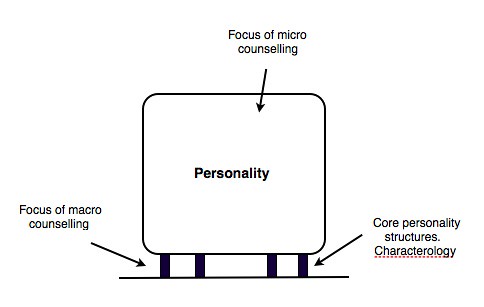In the previous post I talked about micro issues and macro issues. This of course leads to micro counselling approaches and macro counselling approaches. I have tried to conceptualize this diagrammatically as such.

This diagram shows that the personality rests on a few basic structures. As a young child develops it will establish a few core personality structures and this can be seen to form the basic character of the child. This of course will be a combination of the child’s natural temperament plus the early decisions it makes from the Little Professor ego state (A1 ego state).
The term treatment plan as used here is that plan which addresses the core personality structures of the client. This will identify the overall direction the client can go in therapy and this is shown as the macro counselling approach. Macro counselling addresses these core structures directly. Micro counselling does not focus on nor address the core structures, instead it will address the personality features which rest upon the basic core structures.
Micro counselling is the vast majority of activity that occurs in counselling. Macro counselling is not so much what therapist does and are not the techniques employed but it is how the therapist goes about what he does or the basic parameters the therapist imposes on the therapy.

As I said before I have listened to my thinking in the past few days as I developed an understanding of the core personality structures in the client and then how I go about devising the macro counselling approaches.
The first thing I noticed was there was not much of a plan to how I went about this. Instead my thinking was quite haphazard as I discovered the core structures. What ever the client happened to be talking about defined what I thought in my formulations. The ones I thought of are added to the list I started to construct in the previous post.
Personality types - I use these a lot.
Fixated developmental stage
Current developmental stage
Attachment style
Compulsion to either thinking, feeling or behaviour
Primal reaction of flight, fight or freeze.
Behaviour patterns that have been consistent through childhood, adolescence and adulthood.
Six basic temperament features formulated in the New York study
(I am sure there are more and I do not fully understand the nature of the list I am creating here)
Of particular interest is when a client becomes highly regressed in therapy. This is when one will see the core personality structures being displayed. The more regressed a client becomes the more they will resort to their primal ways of problem solving. If a client’s primal response to stress is flight one will see this expressed more openly when they are in a highly regressed state.

Below is a list of some of the core decisions of the personality types. Much more is involved in the personality types but this does provide some of the core structures one would find in the different personality types.
Paranoid - The world is hostile so don’t trust anyone and deal with people by being angry and attacking
Schizoid - The world is scary so withdraw from it (people) and don’t show any of your feelings
Schizotypal - The world is scary so withdraw from it (people) and don’t think clearly by being a bit crazy
Antisocial - You can’t trust anyone & life’s unfair so take advantage of people and do what you like
Borderline - Relationships & life are very unreliable so frantically do anything to keep people around
Histrionic - I must be the centre of attention so I will be dramatic, flirtatious and highly emotional
Narcissistic - I have always been told that I am very important and the best so I will behave and feel like that
Avoidant - Life is scary and rejecting so I will withdraw and feel worthless
Dependent - I can’t cope with life and am worthless so I will cling to others and do what they tell me
Obsessive/compulsive - I have to feel in control of life and myself so I will be orderly and perfectionistic

Graffiti
I am assuming that someone can have several personality types? Is one always dominant ? Can they coexist? Has a healthy person got a good balance of several.
ReplyDelete?
Hello Kahless,
ReplyDeleteEach of us has a personality, or at least I have never met a person who does not have one. So we only have one personality and therefore one can ascribe one of the personality types ot it. Of course we will all have aspects of the various types but there is one basic type. Sometimes the fit is good and sometimes not so good. Can you guess yours Kahless?
Graffiti
Reading those personality types makes me think I have the first half of one and the second half of another.
ReplyDeleteOf course, that may change next week.
Not unless you have a multiple personality disorder Linda. I imagine you have only one personality which will fit into a category to some degree. Don't think at the surface level where we all have many different aspects of our personality. That little 3 year old girl in you made some basic conclusions about life which will determine her basic personality and that is what the personality types are about.
ReplyDeleteGraffiti
Well I know I don't have a multiple personality disorder. Multi faceted persona maybe. I do know which one is my personality though - you would hope so after therapy because it helps to acknowledge it. And fortunately I am okay with it (not sure if everyone else is though - ha ha).
ReplyDelete